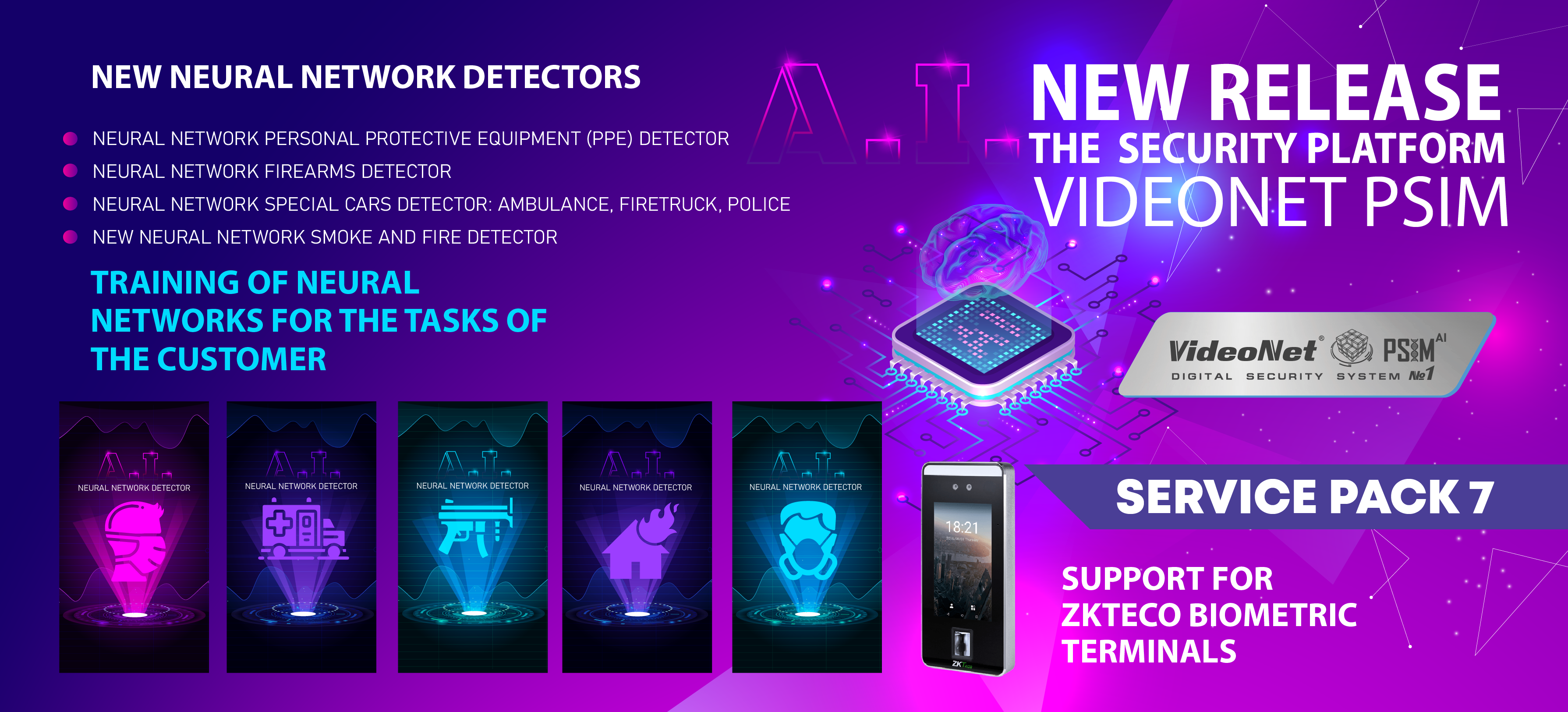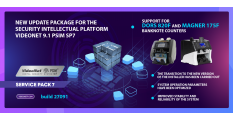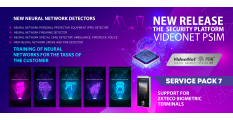The release of the VideoNet PSIM SP7 platform includes new neural network detectors - a personal protective equipment detector, a firearms detector, a special cars detector, new neural network smoke and fire detectors, and a detector for determining the presence or absence of a mask. The VideoNet platform implements the possibility of training neural networks for the customer's tasks. To organize smart identification of employees, integration of ZKTeco biometric terminals into VideoNet was implemented. The transfer of video data and faces from the VideoNet system to the ECHD has been implemented.
New functionality:
- Neural network personal protective equipment (PPE) detector
- Neural network firearms detector
- Neural network special cars detector: ambulance, firetruck, police
- New neural network smoke and fire detector
- Neural network detector for determining the presence or absence of a mask
- New detectors for determining types and clusters of objects
- Training of neural networks for the tasks of the customer
- Connecting new neural networks to a working system without reinstalling it
- Support for ZKTeco biometric terminals
- Integration with ECHD. Transfer of faces under the ECHD regulations (PARSIV).
- Added management of any devices connected to VideoNet in the area of view of a particular camera from the context menu.
- Added support for new Bolid devices (core version 1.20.3.14661)
- Logging user login to VideoNet system via Web-client/mobile client/light client
- Auto search for QUEST IP controllers connected via Ethernet
- Choosing when creating a report to turn on or off line numbering in a report
Neural network analytics
VideoNet uses artificial intelligence and the PSIM approach to building a unified security system at facilities. Using the functionality of VideoNet PSIM, unique solutions are created that significantly increase the level of security of any object and allow solving problems that cannot be solved by traditional means.
New features of VideoNet help to identify dangerous situations and automate the processes of security and surveillance of the facility and use the video surveillance system to solve business problems.
Neural network personal protective equipment (PPE) detector
The neural network personal protective equipment (PPE) detector automatically detects the wearing of personal protective equipment by employees: vests, helmets, goggles. Neural network PPE detector finds people in the image from the video surveillance camera and determines the presence or absence of personal protective equipment on them, fixes the violation, warns the relevant services about the violation of safety regulations.
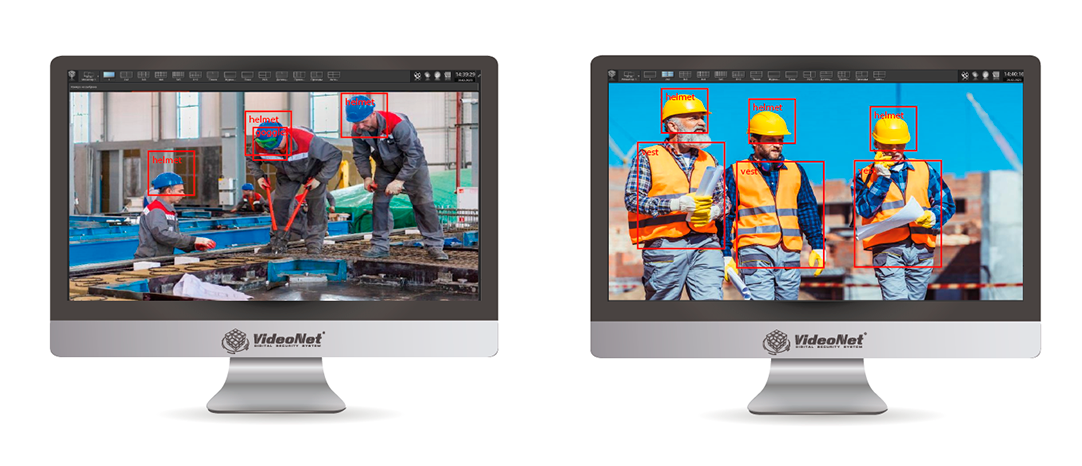
This functionality is in demand by enterprises, construction companies, which, due to safety violations, suffer multimillion losses, and their employees are injured. The detector can be used for early detection of safety violations, for systematic detection of violations, and in complex work with other neural network detectors that determine the presence of people and equipment in a hazardous area.
Neural network firearms detector
Neural network firearms detector is designed to detect firearms. The detector finds objects similar to firearms in the image from the video surveillance camera and, in accordance with the specified settings, notifies the operator, security service or law enforcement agencies about this. Appropriate action is taken when the event is confirmed to be true.
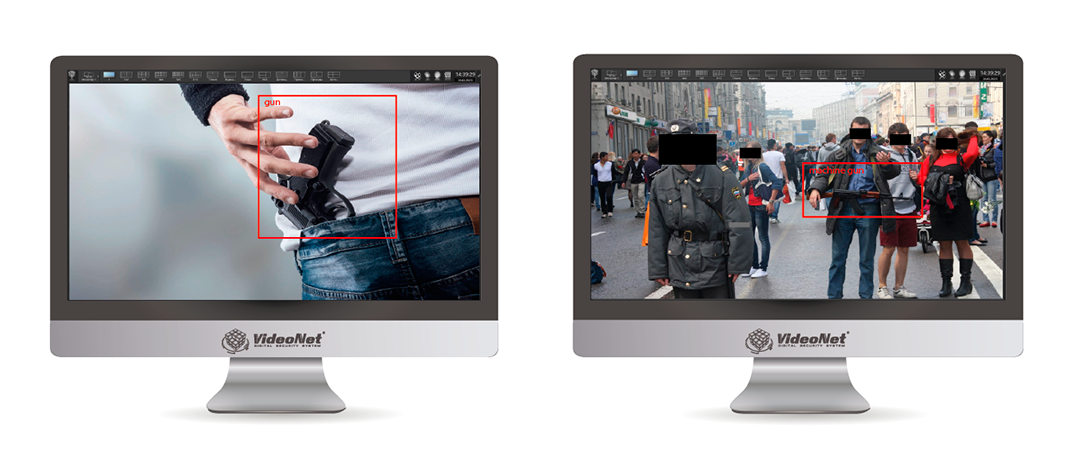
The detector is designed as an additional tool to improve the anti-terrorist security of educational, social institutions, strategic facilities.
Neural network special cars detector
Neural network special cars detector is designed to detect special vehicles: ambulance, police, firetruck. The neural network detector is used to organize unimpeded access of special vehicles to the territory closed by the barrier, without a schedule or operator participation.
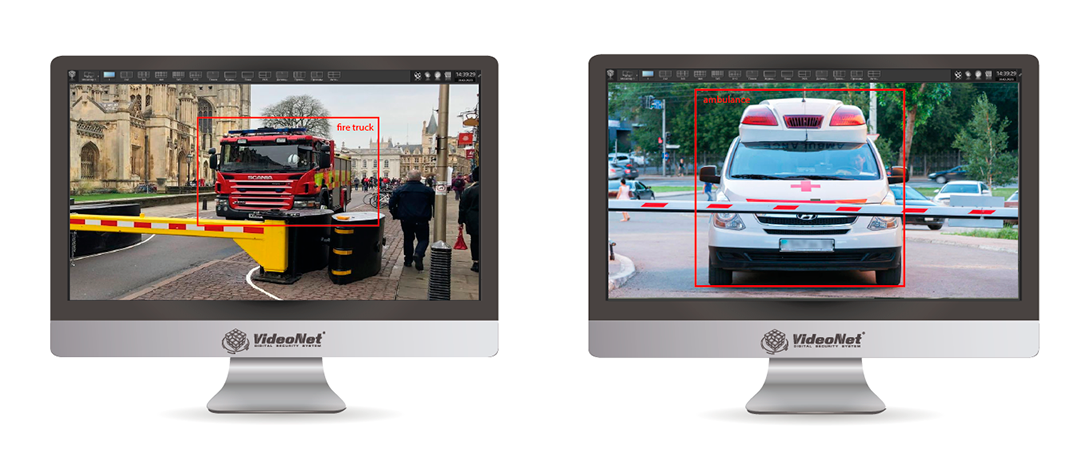
Neural network special cars detector recognizes a vehicle by its appearance. In the settings of the VideoNet platform, you can set the automatic opening of a barrier or gate in response to the event of recognition of a special vehicle, notification of a guard or a dispatcher, the start of recording from video surveillance cameras, or another reaction to an event.
The solution is relevant for homeowners associations and management companies to comply with the requirements for unhindered access to the territory of special services and to minimize the time of their passage through the barrier. Neural network special cars detector can be used as part of a solution for automating the passage of vehicles to the territory with license plate recognition or as a standalone solution.
Neural network smoke and fire detector
VideoNet has added a new smoke and fire detector based on neural networks. The smoke detector will detect pockets of smoke at the protected site and will allow organizing early warning of a fire, the fire detector will detect fires in the protected area, organize a fire warning, provide timely notification of personnel and the response of security systems to an emergency at the facility.
The detector is used to monitor hazardous events - smoke, fire - and can be used as an additional fire detection tool in conjunction with fire alarm sensors or as an independent fire detection tool.

The use of a detector will be useful in facilities where it is not possible to install a fire alarm system. For example, in street parking lots, in enterprises with a large territory, or for the rapid detection of fires in open spaces. Using a detector will reduce the time to detect a fire and ensure a prompt response from the operator.
The neural network smoke and fire detector, unlike the classic smoke and fire detectors that are part of the VideoNet platform, is trained on a large array of smoke and fire images and on images of objects that may be present in scenes with a possible fire. The presence of data with different backgrounds in the training sample ensures high accuracy in determining the presence of smoke and fire.
Neural network mask detector
Neural network mask detector helps to identify violations of sanitary and epidemiological requirements and ensure safe working conditions for employees in the face of epidemics and seasonal diseases.

The use of this detector as a detector for checking the availability of personal protective equipment is relevant for medical institutions and pharmacies.
The functionality allows you to monitor compliance with the established rules when visiting the facility and informs about the lack of personal protective equipment for employees and visitors.
Determination of the presence or absence of a mask on a face is based on a neural network algorithm, based on the result of determining the absence or presence of a mask, you can set up various options for informing and responding, and then use the data to take action against violators.
Neural network object type and clusters of objects detectors
The neural network detectors of types and clusters of objects have been updated in the system. The neural network object type detector identifies and classifies objects of the following types in the frame: a person, a car, a bus, a truck, a motorcycle, a bicycle, a boat, a train, an airplane, a dog. The accuracy of recognition of object types is not affected by weather conditions, change of time of day, or illumination. One possible use of the detector is to detect people or other objects in hazardous or restricted areas. The detector can be used to detect people in dangerous areas, to track intruders, for example, detecting parked cars on sidewalks or lawns, walking dogs in places where it is prohibited.
The clusters of objects detector responds to the appearance of selected types of objects in the monitored area. You can set the threshold value for triggering the detector based on the number of objects in the specified zone. The detector uses an object type recognition algorithm and performs categorization by object types.
This detector is useful for organizing the work of personnel at various service points for people and equipment (shops, customs terminals, parking lots, etc.). The detector is in demand among transport and logistics companies, in trade and in areas where it is necessary to obtain information about the accumulation of detected objects.
Training of neural networks for the tasks of the customer
The new functionality of VideoNet allows to:
- Train neural networks for the customer's tasks
- Connect new neural networks to a running system without reinstalling it
We use neural networks with high accuracy and quality of information perception for pattern recognition and create a unique product that can solve individual customer tasks.
We can train a neural network to:
- Detect - recognize a certain type of object.
- Classify - identify the types of different objects and sort them into separate groups.
- Track - control the movement of objects in a given area.
Support for ZKTeco biometric terminals
To expand the capabilities of the access control system with multi-factor identification, VideoNet has added the integration of ZKTeco biometric terminals:
- ProFace X (temperature measurement model ProFace X(TI))
- SpeedFace-V4L
- SpeedFace-V5L [QR]
Biometric terminals are convenient and easy to mount on turnstiles at checkpoints and at the entrance to the premises. The terminal can be used as the optimal solution for organizing contactless face access.
Building solutions using ZKTeco equipment allows you to organize smart identification of employees for access to various premises and at access points. The solution allows you to organize multi-factor access identification, if necessary, measure the temperature and check the presence of a mask.
Supported operating modes:
Identification. You can use a single identifier by which the system will decide to grant access. As the only identifier, you can choose a recognized face, key, palm, code.
By code or key, or face, or palm. To access the object, you can use one of the identifiers to choose from.
Verification. An object is accessed based on the coincidence of several identifiers. Possible options: by face and code; by face and key; by palm and key; by palm and face; by code and key.
The operating modes of the terminal can be combined with measuring the temperature of a person and determining the presence of a mask. The possibility of using this functionality depends on the terminal model. In this case, you can enable temperature measurement with prohibition or granting access to the object when the allowed temperature is exceeded or there is no mask.
ZKTeco biometric terminals can control various actuators: electromagnetic and electromechanical locks, turnstiles of all manufacturers on our market. Terminals are connected to VideoNet software via TCP/IP protocol.
Transmission of video data from the VideoNet system to the ECHD
The new functionality of VideoNet PSIM enables users to transfer information from surveillance cameras to the state information system "Unified Data Storage Center".
VideoNet implements the second type of connection to the ECHD, when the video archive is stored directly at the facility. Surveillance cameras are connected to the server with the VideoNet software at the facility, and the server is connected to the ECHD. Additionally, the transfer of faces found in the field of view of the camera is implemented in accordance with the ECHD (PARSIV) regulations.
Managing devices in the camera's field of view from the context menu
To control any devices connected to the VideoNet platform, you can configure a custom command and add a command to the context menu of the video camera in the field of view of which the device is located.
Functionality is in demand for systems with a large number of equipment for rapid response by the security service to an event. Binding a user command to a specific video camera allows you to call a command from the camera menu. To control devices in the field of view of the camera, the operator does not need to know their names in the VideoNet system and their physical location on the object. For example, an operator can quickly open a door where a person is standing, open a barrier for a car to pass, block a turnstile, turn on or off the lighting.

